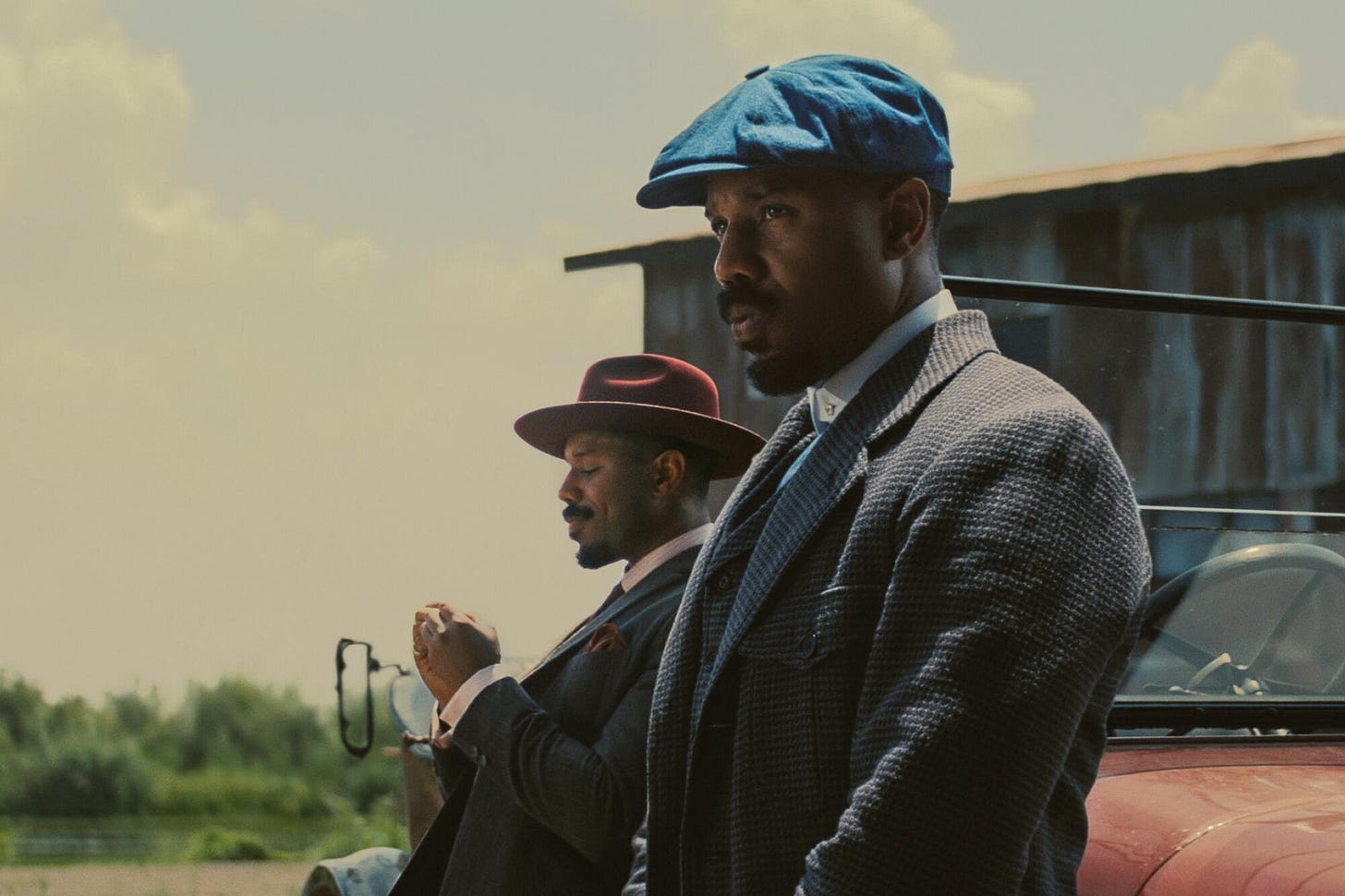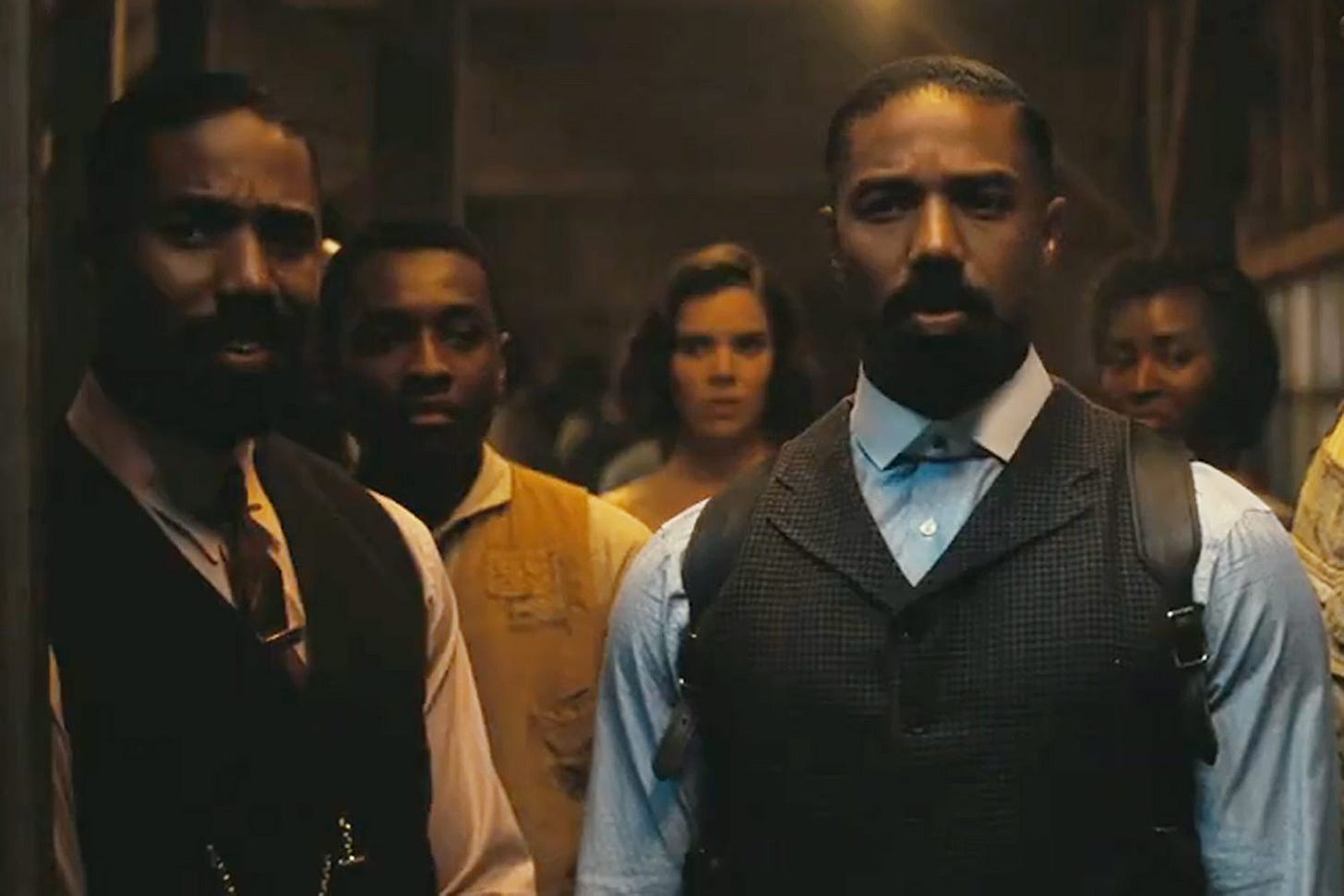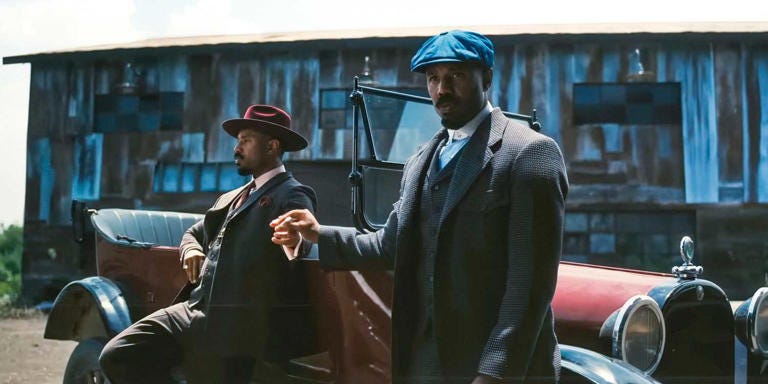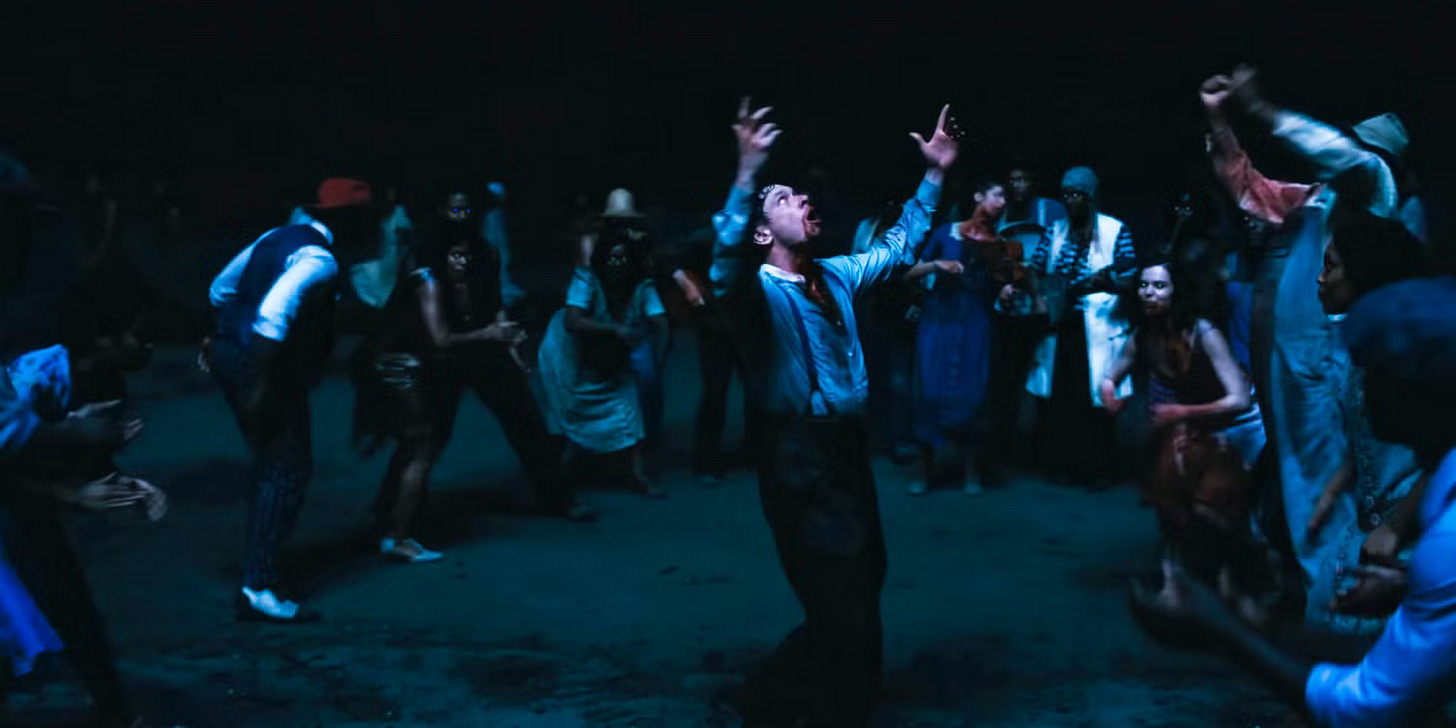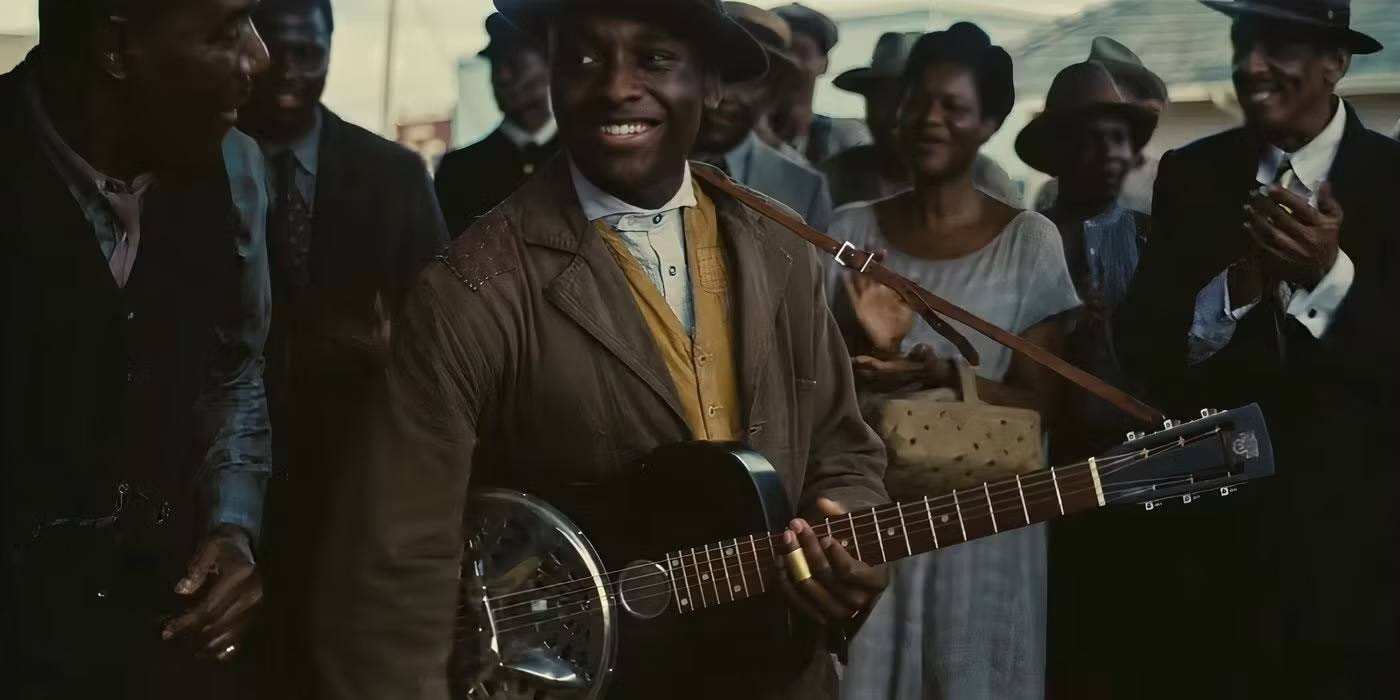SINNERS (2025): A different take on Ryan Coogler's vampire masterpiece
Potential spoilers follow....
Shea and I went to see SINNERS last night, at a pretty busy early evening IMAX screening, and it stayed with me in the best possible way. As such, I have an interpretation that I haven’t seen elsewhere, so figured it could be fun to write about.
The premise is beautiful: some people are so good at making music, they attract evil.
I could honestly write a whole essay on that alone — there’s an expansive history of iconic musicians who that premise could apply to.
But let’s stick to the movie. The set-up involves black twins (Smoke and Stack) escaping gangsters in Chicago to set up a juke joint back home, using the musical gifts of their cousin (Sammie) to bring in an audience.
The villain’s a white (Irish) vampire (Remmick), who bites down on a couple of klan members to make his own little band, so he can try to steal Sammie’s skills to connect with the ancestors he can no longer see – in this life or the next.
From the plot, you might think that this is a pretty simple allegory – white predators try to suck the talent and lifeforce from black victims, but SINNERS is a little more nuanced than that.
Whenever an auteur-driven film like this lands, one of the first things I do is research the names of the main characters, there’s usually some potential keys to unlocking meaning and intent there.
With that in mind, combine Smoke and Stack (unusual names, clearly with layered meaning) and you get smokestack – a slang term for ‘industries or businesses that are heavily involved in manufacturing, especially those using large-scale factories and often associated with older, traditional industries like steel or automobile production.’
Or… music.
Think of the term ‘manufactured pop,’ or that we discuss musicians’ place in the ‘music industry’ – the industrialization of music is at the heart of how we talk about it.
So where does this place the twins in the good/evil balance?
Good, in that they’re created a space for their culture – a black owned business, for black people, celebrating black music. Potentially bad, because the enterprise is entirely money-driven.
When Stack hears the power of Sammie’s voice, he’s first awed by it, and his reaction has an emotional power for the audience – but that immediately becomes a celebration of how much money they’re going to make, and it undercuts the moment.
There’s a later scene where the brothers argue over the idea of plantation tokens being accepted at their juke joint, instead of just cold cash. If slaves want to rave, they have to pay.
Meanwhile, cultural outsiders – initially turned away – are welcomed when it's revealed they have old gold to spend.
And what of Remmick’s name? There’s a couple of takes – both amazing.
‘The name Remmick is an Americanized form of the German name Roemmich and the French name Rémy. It ultimately derives from the medieval personal name Remigius, which can be traced back to the Latin words "remex" (rower, oarsman) and "remedium" (remedy). Therefore, the name Remmick can be interpreted as "rower" or "remedy," depending on the specific derivation.’
We can instantly tie the ‘remedy’ meaning to the character – he sincerely believes that vampirism is a way to bring people together; the vampires have a culty vibe, one that believes this kind of death leads to love and understanding (the vampires have access to each others memories – or, their history – as soon as they’re turned).
So, death - cultural death, via homogenization or appropriation - is a cure for conflict, a remedy.
The ‘rower’ connection is a little stranger.
‘A rower is a person who rows a boat, especially as a member of a racing team.’
Let’s really reach for this one – why not?
The vampires are a team, a perfect team in many ways. They work together in total unison, whether performing music, or attacking as a group: whatever happens to them after they turn, it connects them in profound ways.
They move their instruments like rowers aiming for the rhythm and harmony that allows them to travel forward faster.
Of course, the twins are a team too – they work in unison to light a cigarette, and to bring together the elements they need for their business.
The fact they’re twins connects them to a poetic and mythological symbolic history of duality, but also healing: of remedy. For the brothers and vampires, working together is a revival.
Then there’s the whole rowing thing. How did black people come to America? On boats – forced to row their passage to slavehood. How did Irish people come to America? On boats, working as indentured servants (not the same as slavery) to secure passage. There’s a potential duality here too.
Both were treated as second-class citizens in America, both discriminated against, both oppressed, but their hardships did not connect them.
“The commonalities of African Americans and Irish Americans in social status and economic standing could have set the two groups as allies, but the divide that ensued destroyed this likely union. While the Irish seized the opportunity they were presented to assimilate, African Americans continued to face racial prejudice and violence, sometimes even at the hands of the Irish, despite the relationships of abolitionists like Frederick Douglass and Daniel O’Connell.”
So where does this place Remmick on the good/bad divide? Bad, he’s trying to homogenize black culture for his own personal, spiritual, gain — to assimilate against the twins’ wishes. Potentially good; he’s a victim too, of whatever it was that turned him, and of the history of his people (which is his driving desire in the narrative).
He also seems sincere when he offers the opportunity for revenge against the KKK. He seems to want unity, even if it is on selfish terms. He requires consent – like a record executive, you have to sign a (verbal) contract to let him in before he can take from you. And he gets his own, celebratory moment of dance, even if he is the center of the worship circle.
But there’s one more interpretation of the name. ‘Remick is a topographic surname, which was given to a person who resided near a physical feature such as a hill, stream, church, or type of tree.’
I haven’t even begun to dig into the religious themes of the movie — which is weird in a film called SINNERS, centered around a pastor’s son, which features both a baptism and (many) resurrections, but this idea of connecting Remmick to church adjacency is interesting.
After all, he comes to a place of sin and wants to transform it in his image – he believes that once everyone has the same thoughts as him, the world will be a better place. I’m not going to get into any third act spoilers, but even Sammie’s circular narrative scene is a fascinating one in this wider context.
The juke joint could be seen as a church, worshipping music, which is seen through a spiritual, even transcendent eye in the movie’s best set-piece (you’ll know it when you see it), which moved me in ways only the sublime can.
Who are the sinners? Those who come to create, those who come to celebrate, those who come to destroy, or those who come to control? And what choices do we make in the face of that sin, especially when we create art so beautiful it makes the devil dance, then follow us home after the party?
There’s a post-credit choice to end the film on a character singing ‘This Little Light of Mine,’ which was sung in churches, but also during the civil rights movement – and it also connects, at a stretch, to the act of making art.
Because what is ‘this little light of mine, I’m going to let it shine,’ if not a call to share your talent for music, for movies, or more?
I feel like Ryan Coogler’s showing his hand here — this coda is the ultimate message of SINNERS.
Even if there are evil forces who want to take without credit - I’m thinking of those who took from Sister Rosetta Tharpe, who sang her own electric guitar-led gospel version of ‘This Little Light of Mine’, and who should be a household name for how much she helped create rock’n’roll - we must continue to make our music.
No matter what industrial / industry demons circle us, to continue to create in the face of evil is to shine a light for those who want to follow.
And there’s no better way to kill a vampire than to let that light hit their skin.



